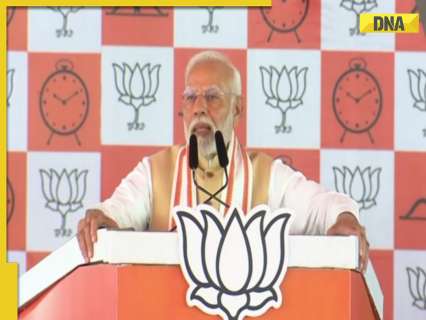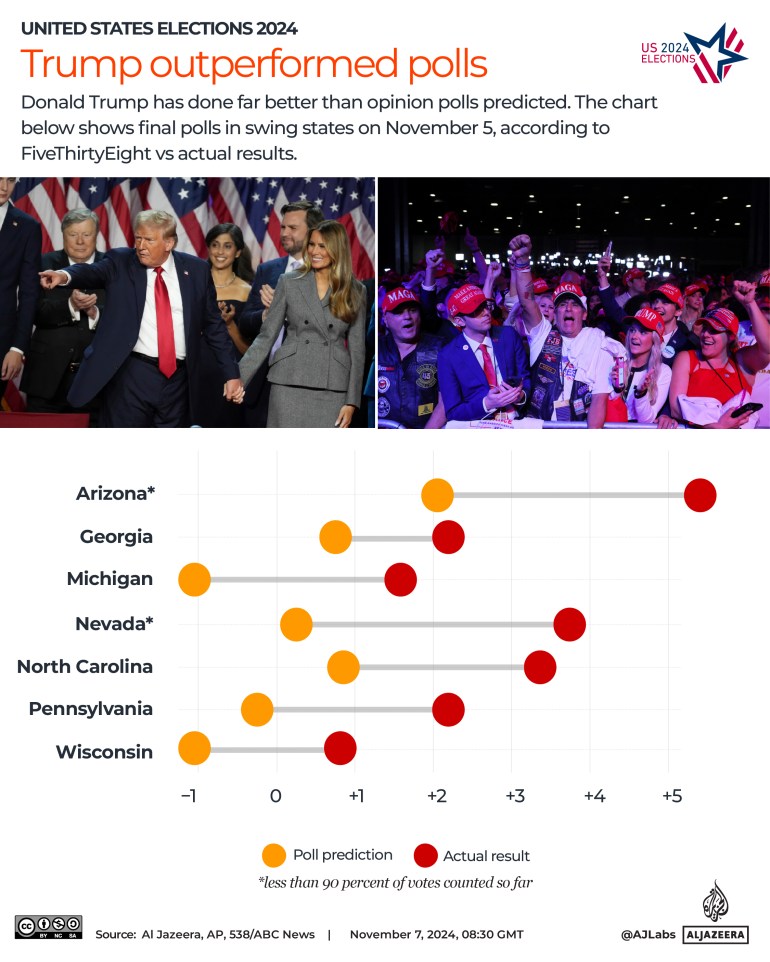Trump administration could lead to budget cuts, leadership shakeup at UN

A Donald Trump presidency is sure to have reverberations at the United Nations (U.N.), and first on the chopping block could be its funding. The U.N. currently relies on the U.S. for about a third of its budget. President Biden increased U.S. financial contributions to the U.N., boosting it from $11.6 billion in 2020 to $18.1 billion in 2022. This gives a new administration wiggle room to withhold funds to the U.N. if its global interests do not align with the U.S.’, a notion some Republicans have already pushed for. The U.S. gave about three times as much that year as the next-highest contributors, Germany at $6.8 billion and Japan at $2.7 billion. “They will have to recalibrate now very much again in the Trump administration that will, I believe, be much more attentive, engaged and monitoring of the U.N.,” predicted Hugh Dugan, a longtime member of the U.S. delegation to the U.N. “There are teams there that have been sleepwalking the last few years without U.S. pressure on accountability, efficiency and effectiveness.” Trump will be in office when the international body elects its next secretary general in 2026, and the U.S. will have veto power over any candidate. “Over the next year and a half, it’s going to make an effort to look more managerially competent to avoid some of the stern green eyes seated across here – attention that Elon Musk and the Trump team will want to bring to the consideration of the secretary general selection.” ISRAEL’S UN AMBASSADOR: RESPONSE TO IRAN WILL BE ‘VERY PAINFUL’ Trump would also likely once again withdraw the U.S. from the Paris Climate Accords and the U.N. Global Compact on Migration. The U.N. particularly relies on the U.S. for global aid programs. In 2022, it provided half of all contributions to the World Food Programme, and about a third of all contributions to the U.N. High Commissioner for Refugees, the United Nations Relief and Works Agency for Palestine Refugees in the Near East (UNRWA) and the International Organization for Migration. “There’s no doubt the U.N. is frightened and horrified,” of Trump taking office, said Hillel Neuer, executive director of U.N. Watch. “We’re going to see budget cuts,” he said. “The most memorable being UNRWA.” Trump cut funding to the organization that distributes aid to Palestinians in Gaza. Biden led the U.S. in reinstating that aid and earmarking $1 billion for UNRWA – before freezing that aid when it was revealed that some employees had links to Hamas. “I would say the Human Rights Office, which is based in Geneva, the U.N. Human Rights Council, America gives voluntary funds to that bureaucracy. I could see that being cut,” Neuer said. Some wonder whether Trump and a Republican-led Congress might try to withdraw the U.S. from the U.N. entirely. The GOP-controlled House passed a spending bill in June that would eliminate funding for the U.N.’s regular budget. However, despite an adversarial tone toward global institutions, Trump is not expected to stop dealing with the U.N. altogether. In his first administration, he enjoyed a good relationship with Secretary General António Guterres, inviting him to the White House, and seemed to enjoy his yearly address to the General Assembly and the pageantry of world leaders traipsing through the New York City headquarters. “He engaged personally up there quite a lot. And during the opening of the General Assembly, he brought the White House up there, frankly, and lived up there for that week every year and operated. He recognizes the value of the organization, if just as a meeting place,” said Dugan. UN REMOVES QUILT PANEL ARTWORK CALLING FOR ISRAEL’S EXTERMINATION AFTER FACING BACKLASH Trump could also seek to push candidates for leadership over agencies like UNICEF and the World Food Programme that challenge U.N. orthodoxy and encourage American employment across the agency to counter China’s growing influence. China doubled the number of its nationals employed at the U.N. to nearly 15,000 from 2009 to 2021. “This was very much in the mind of the Trump administration when I worked in the White House that China’s growing its influence in subtle and not so subtle ways throughout the organization, affording it a globalized platform of legitimacy that they’re ready and willing to exploit to their national ends,” said Dugan. “The U.S. has to study the terrain of the organization better and identify, in particular, the key posts and influential offices that we should show up with our best talent and make sure that we are effective. The Chinese have been doing that really well.” Additionally, though the Biden administration did buck a number of U.N. resolutions that targeted Israel, he was naturally more supportive of international organizations as a whole.
Watch: Gujarat family holds Rs 4 lakh samadhi ceremony for their ‘lucky’ car after 12 years of service

Sanjay Polara, the head of the family, explained that the car had brought success in his construction business and respect for his family.
This is India’s second richest city, home to 57 billionaires, it’s seven expensive residential areas are…

These seven locations in Delhi are considered some of the most expensive places to live in the city.
PM Modi attacks Congress in Nashik rally, says party wants to create rift among OBCs

He said the people of Maharashtra are seeing the manifesto of ‘Mahayuti’ and the ‘ghotala patra’ of the Maha Vikas Aghadi (MVA). The MVA includes Congress, Shiv Sena (UBT) and NCP (SP).
Voters decide on climate measures, reject initiative to tax natural gas powered buildings in California city

On Tuesday, voters in various states decided on ballot initiatives that would determine whether to expand and fund environmental and climate-related projects in their states. In Berkeley, California, voters shot down a ballot measure to impose a tax on buildings 15,000 square feet or larger using natural gas, or appliances such as gas stoves for heat. At the state level, California voters passed a ballot measure to finance climate projects across the state. California voters passed Proposition 4, which will create a $10 billion taxpayer-funded bond for climate projects, including improvements to drinking water, wildfire prevention efforts, and protecting coastal areas from rises in sea level. BIDEN-HARRIS EPA FUNDING ‘RADICAL, LEFT-LEANING’ ENVIRONMENTAL GROUPS CALLING TO END FOSSIL FUELS: REPORT Prior to its passing, opponents of the measure warned that there would be financial implications for such projects and that the state should not take a loan-based approach to climate-related mitigation. On Election Day, voters in Washington rejected an initiative to repeal the state’s climate policy. CLIMATE ACTIVISTS COVER US EMBASSY IN LONDON WITH ORANGE PAINT AFTER TRUMP’S PROJECTED WIN Residents voted against Washington Initiative 2117, which would have repealed the state’s Climate Commitment Act, which aims to reduce greenhouse gas emissions by 95% below 1990 levels by 2050. The measure would have repealed the 2021 law and prohibited state agencies from implementing any carbon cap-and-trade system. Proponents of the bill have heavily criticized the law and claim the current carbon tax has increased energy costs. A group opposing the bill, however, told Fox News Digital that passing the measure would mean “more pollution in our air and water.” “Washingtonians said loud and clear that they value clean air and clean water — and they don’t want to go backwards,” Gov. Jay Inslee said in a statement. “Washingtonians showed that they reject cynicism, and they support action and innovation to protect our kids’ and grandkids’ health. This a victory for clean air, clean energy jobs, and a stronger economy in the Evergreen State.” Rhode Island passed Question 4 on their ballots for a $53-million bond for land preservation, while Minnesota voters voted in favor of Amendment 1 to earmark funds from the state lottery to the Environment and Natural Resources Trust Fund for environmental projects.
Cornyn touts lifetime fundraising prowess for GOP in final case to succeed McConnell

FIRST ON FOX: Sen. John Cornyn, R-Texas, revealed his updated fundraising for Republicans this election cycle on Friday, which puts his all-time total at nearly $415 million, in a final pitch to Senate colleagues just days before the Republican leader election to replace Senate Minority Leader Mitch McConnell, R-Ky. A source familiar with Cornyn’s political operation told Fox News Digital that the Texas Republican ultimately raked in $33 million in the 2024 election cycle. The total included $16 million for the National Republican Senatorial Committee (NRSC). TOP REPUBLICAN PRIVATELY BACKING THUNE TO SUCCEED MCCONNELL IN GOP LEADER RACE “I’m deeply grateful to the thousands of Americans who contributed to our efforts this cycle,” Cornyn said in a statement on the fundraising figures. “Their unprecedented support helped build the resources needed to advance our shared priorities in the Senate. This historic level of engagement reflects the deep commitment of voters who want to see effective, conservative leadership in Washington.” The massive 2024 haul brings his total money raised in his Senate tenure to roughly $415 million, the source said. Cornyn is seeking to succeed McConnell as leader alongside competitors Senate Minority Whip John Thune, R-S.D., and Sen. Rick Scott, R-Fla. The election will be held via secret ballot on Nov. 13. RICK SCOTT SEES RED WAVE AS ‘BEST CASE SCENARIO’ FOR SENATE LEADER BID AS HE LOBBIES TRUMP FOR SUPPORT Fundraising ability is considered a significant factor in the upcoming Republican leader race, because the winner will become a symbol of the GOP Congress and be relied on to drive resources to key Senate races. This is the role McConnell took on throughout his time, during which he became known as a fundraising juggernaut. Over the course of 2024, Cornyn has publicized his fundraising data for both colleagues and donors to see. The senator has notably maintained the status of top Senate Republican fundraiser behind McConnell for 15 years, the source further pointed out. The Texas Republican created the Cornyn Victory Committee in 2021 to assist Republican campaigns. During the 2021-2022 election cycle, the committee’s fundraising efforts brought in $20 million, which the source noted was more than any of his GOP colleagues other than McConnell and then-NRSC Chair Scott. CHUCK SCHUMER PREPS FOR RETURN TO SENATE MINORITY AFTER GOP VICTORY While Cornyn has proven significant ability when it comes to driving resources, Thune has also made a name for himself when it comes to fundraising. A source familiar with Thune’s political operation shared with Fox News Digital that he also pulled in $33 million this election cycle, matching Cornyn. The source pointed out that Thune either raised money or campaigned in Nevada, Montana, Wisconsin, Michigan, Indiana, Ohio and Pennsylvania, which were all home to Senate races, in the homestretch of the cycle. Thune has also raised money through his super PAC, New Heights Action, and 501c4 group New Heights for America, bringing in $22.3 million this cycle. The groups are led by John DeStefano, who is a former senior Trump administration official. MITCH MCCONNELL SINGS TRUMP CAMPAIGN PRAISES: ‘SHARPER OPERATION THIS TIME’ In the last few months, Thune’s team has highlighted his travel during the Senate recess, particularly his campaigning on the ground with candidates. Cornyn’s travel schedule has not been made public in its entirety, but the senator has often opted to take advantage of the reliable fundraising boon that his home state of Texas has been for Republicans. His political operation pointed Fox News Digital to several public events in Michigan, Nevada, Indiana, Ohio and Pennsylvania since August. The source said that in October the Texas senator raised $1 million in one day for Senate Republican candidates in Ohio, Montana, Michigan and Wisconsin at events in Dallas and Houston. Scott spent the 2024 cycle on his own re-election bid in Florida, which proved greatly successful on Tuesday night. The senator handily won his race by a larger margin than predicted.
In & Out: Trio of longtime Dem senators elected same year were voted out in 2024

A trio of Democrat senators who were all elected during the blue-wave 2006 midterm cycle lost their re-election bids this week in a devastating blow to the party as the GOP regains control of the Senate. Pennsylvania Sen. Bob Casey, Ohio Sen. Sherrod Brown and Montana Sen. Jon Tester have served as Democrat stalwarts since they were sworn in 2007, but they watched their Senate careers end this week as they faced high-stakes challenges from Republicans. Fox News projected on Wednesday that the Republican Party flipped the Senate red, holding 53 seats as of Thursday afternoon. Pennsylvania Sen. Bob Casey was projected to lose his high-stakes race against Republican challenger Dave McCormick on Thursday afternoon as Pennsylvania officials waded through votes in the razor-thin race. McCormick received 48.95% of the vote to Casey’s 48.49%. The Casey name has deep roots in Pennsylvania, not only from the longtime Democrat senator but also his father, Bob Casey Sr., who served as the Keystone State’s governor from 1987 to 1995 after years of serving in various other elected roles. TRUMP-BACKED PA SENATE CANDIDATE FLIPS LONGTIME DEM SEAT RED IN NAIL-BITER ELECTION Casey Jr. launched his first Senate campaign in 2005, working to unseat Republican Sen. Rick Santorum and flip the seat blue. Bolstered by his father’s wildly popular legacy and winning platform, Casey Jr. sailed to victory in the 2006 election, holding onto the seat for nearly 18 years. Trump-endorsed Dave McCormick launched his Senate campaign to unseat Casey this cycle and officially declared victory in the race on Thursday as certain Pennsylvania jurisdictions continued counting votes after experiencing some voting hiccups on Tuesday. McCormick portrayed Casey as an out-of-touch longtime politician with close ties to the Biden-Harris administration who put D.C. politics ahead of advocating for policies that benefited Pennsylvanians and voters nationwide. Ohio Democrat Sen. Sherrod Brown, who has served in the Senate since 2007 and has been in politics for half a century, was considered one of the most vulnerable incumbents heading into Tuesday night, and he ultimately fell to his GOP challenger as Trump carried Ohio by more than 10 points. ‘TIRELESS CAMPAIGN’: REACTIONS POUR IN AFTER GOP CHALLENGER FLIPS CRUCIAL SENATE SEAT HELD BY LONGTIME DEM Brown, who lost to Cleveland area businessman Bernie Moreno by about four points, attempted to highlight areas where he disagreed with President Biden but was ultimately weighted down by a voting record that was nearly 100% in line with the president and a climate of opposition to illegal immigration and a difficult economy. “This is a disappointment but is not a failure,” Brown said in his concession speech. “It will never be wrong to fight for organized labor, it will never be wrong to fight for the freedom of women to make their health care decisions, it surely will never be wrong to fight for civil rights and human rights.” Three-term Sen. Jon Tester, D-Mont., lost the 2024 Montana Senate race, but his long-held position is remembered by his ability to hold a blue seat for nearly two decades despite the state’s significant shift to red. Tester, a dirt farmer from Big Sandy, was first elected to the Senate in 2006, ousting three-term former Republican Sen. Conrad Burns for the Big Sky State seat he would go on to hold for the next 18 years. Tester’s win notably solidified Montana as a dominantly blue state that year, with two Democrat senators and a Democrat governor. Tester went on to win a second term in 2012 despite being on the ballot with then-Republican presidential candidate Mitt Romney, who won Montana’s electoral votes that year. NAVY SEAL TIM SHEEHY OUSTS 3-TERM SEN JON TESTER IN MONTANA SENATE RACE The state saw a significant shift red in 2014 when Republican Sen. Steve Daines flipped one of the long-held Democrat Senate seats for Republicans, the first of several seats that would eventually turn to the GOP. However, despite President-elect Trump winning Montana by about 20 points in 2016, Tester successfully secured a third term in 2018. Tester broke the mold of many Democrats in Washington, D.C.: a rural American farmer who championed protecting the Second Amendment and funding law enforcement. But as Tester sought a fourth term in the state, he faced an increasingly red electorate. The Democrat’s standing in the state came to an end this cycle after former Navy SEAL Tim Sheehy, a Republican, ousted him in one of the most closely watched Senate races of the 2024 cycle. Get the latest updates from the 2024 campaign trail, exclusive interviews and more at our Fox News Digital election hub.
US election results: How did opinion polls undercount Trump voters again?

Ahead of the United States presidential elections on Tuesday, public opinion polls had predicted a neck-and-neck race between Donald Trump and Vice President Kamala Harris. Yet eventually, Trump cruised to a comfortable victory, defying most polls. He has already won five of the seven swing states – Pennsylvania, Georgia, North Carolina, Michigan and Wisconsin – and appears poised to win the remaining two, Arizona and Nevada. Most of these wins are by margins larger than the polls had forecast. And, while most pollsters had predicted a narrowing margin between Harris and Trump in the popular vote, almost all showed Harris ahead. In the end, Trump is on course to not just win the popular vote – but to do so by a margin of close to 5 million votes. That’s a win no Republican can boast of since George HW Bush in 1988. Overall, Trump has already won 295 Electoral College votes, comfortably more than the 270 needed to win, while Harris won 226. If he wins Arizona and Nevada as is predicted, Trump will end up with 312 Electoral College votes. So how did the opinion polls go wrong – so wrong? What did the polls predict about swing states? Most national polls, weeks into the vote, predicted the two candidates deadlocked, deeming the race too close to call. A few days before the elections, some pollsters, such as poll aggregator FiveThirtyEight then shifted slightly and predicted that Harris was more likely to win, although by a small gap of less than 2 percent. In the seven battleground states, Harris was predicted – based on an average of polls by aggregator FiveThirtyEight – to win a majority in the traditionally Democrat, or Blue Wall states of Michigan, Pennsylvania and Wisconsin. Trump was leading in the polls in North Carolina, Georgia and Arizona, while there was almost nothing separating the two candidates in Nevada, according to the polls. On election night, Trump won all three of Michigan, Pennsylvania and Wisconsin. He is expected to win Arizona handsomely. And he is ahead in Nevada by three percentage points – well beyond what the polls had predicted. What about other states Trump won? In Iowa, the Midwestern state that has long been solidly Republican, Selzer and Co, a trusted polling company owned by analyst J Ann Selzer, surprisingly predicted Harris winning by three percentage points over Trump in the closing days of the campaign. To be sure, it was an outlier poll: an Emerson College poll that came out at almost the same time showed Trump winning the state by nine percentage points. But Selzer is widely respected in the polling industry and has repeatedly called Iowa correctly in presidential and Senate races over the decades. She cited widespread anger among white women over the overturn of hard-won abortion rights by Trump-appointed Supreme Court Judges back in 2022, and said previously undecided women voters were breaking late for Harris, giving her the edge. Trump, on his social media channel, Truth Social, condemned Selzer’s poll, calling her an “enemy” and saying that the poll was wrong “by a lot”. Eventually, Trump won the state by 13 percentage points – more than what even many Republican-funded polls had predicted. When polls get it so wrong, it “exacerbates a key challenge in this race: the perceived lack of legitimacy of polling”, Tina Fordham of risk advisory company Fordham Global Foresight told Al Jazeera. What about states that Trump lost? Pollsters got it wrong even in several states that Harris won – undercounting Trump’s support and thereby predicting a far great margin of victory for the vice president in solidly Blue states than what happened in the election: New York: The polling average at the start of November 5 had Harris winning by 16 percentage points. She won by 11 points. New Jersey: Harris, per FiveThirtyEight, was forecast to win by 17 percentage points. She beat Trump – but only by 5 points. New Hampshire: The polls suggested Harris would win by 5 percentage points. She barely beat Trump by two percentage points. Did pollsters warn of possible errors? Yes, pollsters always point out that their surveys operate within margins of error in their calculations – about 4 percent in many cases. That means that their predictions could be off by 4 percent in either direction: if Harris is shown leading Trump 48 percent to 44 percent, for instance, they could actually end up equal, or Harris could end up with an 8 percent win eventually. Nate Silver, who founded pollster FiveThirtyEight, and now anchors the newsletter, Silver Bulletin, wrote in The New York Times ahead of the vote that his “gut” went with Trump. Silver had earlier predicted a deadlock, but it was possible, he noted, that the polls were underestimating the numbers of Trump supporters because they could not reach them for surveys. But in the final days before November 5, Silver was one of several pollsters who said their models had shifted slightly more towards Harris, giving her a 48 percent chance at victory over Trump’s 47 percent. (Al Jazeera) Have polls got it wrong before? Yes. Polling in the US began from newspapers collecting local opinions in the 1880s. Predictions have often been right, historically. But of late, they have often also been horribly wrong. In 2016, opinion polls correctly predicted the popular vote for Hillary Clinton, but also had her winning, comfortably, in states like Pennsylvania, Michigan and Wisconsin, that Trump eventually won. Their forecast of Clinton winning the Electoral College was proved wrong. Polls were off in 2020 again, when COVID-19 restrictions greatly limited surveys. Most polls correctly predicted that Joe Biden would win the Electoral College and national vote. But they significantly overestimated the support for Democrats by an “unusual magnitude”, according to the American Association for Public Opinion Research (AAPOR), while undercounting voters backing Trump. Researchers called it the least accurate polling in 40 years. Then, in 2022, polls got it wrong the other way – for the midterm
German opposition hits out at Scholz for delaying confidence vote

Conservative leader wants confidence vote now, triggering January election, as poll shows more than half of Germans agree. Germany’s conservative opposition leader Friedrich Merz has slammed Chancellor Olaf Scholz, describing his decision to delay a confidence vote until next year as “irresponsible”. Merz, who leads the Christian Democratic Union (CDU), accused Scholz on Friday of being steered by “party-political motives” after he declined calls for an immediate parliamentary vote of confidence following the collapse of his rocky three-way coalition government this week. The “vast majority” of the German electorate agreed with his view that Scholz, who now leads a minority government with his Social Democrats and the Greens after the Free Democrats (FDP) party exited the coalition, was being “irresponsible”, Merz said. Opposition parties and business groups want an immediate vote, which Scholz would likely lose, enabling elections to be held eight months ahead of schedule in January, a move that they say will minimise political uncertainty. But Merz, who met Scholz on Thursday, failed to convince the chancellor to budge from his original plan of holding the vote on January 15, meaning new elections would not be held until the end of March. Scholz’s coalition fell apart on Wednesday when years of tensions culminated in a row over how to plug a multibillion-euro hole in the budget, with the chancellor sacking Finance Minister Christian Lindner, prompting the FDP to leave the government. As parties positioned themselves, Vice Chancellor Robert Habeck of the Greens party, a 55-year-old former novelist and philosopher, is set to fire the starting pistol on his own bid to become chancellor, according to news outlet Der Spiegel, quoting party sources. The break-up creates a leadership vacuum at the heart of the European Union just as it seeks a united response to the election of Donald Trump as United States president on issues ranging from Russia’s war in Ukraine to the future of the US-led NATO alliance. Attending a meeting of European leaders in Budapest on Friday, Scholz pledged to work with Trump, but stressed that the 27-nation European bloc must remain strong in light of conflicts in Europe and the Middle East. “One question is quite clear. Together as the European Union, as Europeans, we must do what is necessary for our security,” he said. Eyeing the top job, Merz adopted a more strident tone, calling on Europe to take a tougher stance during the upcoming Trump presidency. “This will make an impression in America,” he said on a talk show aired by German public broadcaster ZDF on Thursday evening. “Donald Trump is not impressed by weakness, only by strength, even opposition.” The ZDF Politbarometer, an opinion poll, confirmed that 84 percent of Germans want an election as soon as possible. Some 54 percent want it to happen before Scholz’s projected timeline. Adblock test (Why?)
Thousands evacuated as wildfires ravage homes near Los Angeles

Thousands of people have been ordered to evacuate from a wildfire northwest of Los Angeles as fierce seasonal winds blew flames into ranches and neighbourhoods, destroying dozens of homes. The wildfire has destroyed 132 structures in less than two days, fire officials said on Thursday. Firefighters and police cleared residents from neighbourhoods near Camarillo before homes were set ablaze by embers blown 3.2km (2 miles) from the firefront, Ventura County Fire Department Captain Tony McHale said. “It’s like trying to put out a blowtorch with a squirt gun,” said McHale of the fire, which started in a hillside canyon on Wednesday and tore west, driven by Santa Ana winds. Fuelled by abundant grass and scrub, with wind gusts up to 130km/h (80 mph), the blaze had burned more than 8,094 hectares (20,000 acres) by Thursday evening, authorities said. Several civilians were injured and a “significant” number of homes, businesses and other structures were destroyed, McHale added. Ventura County fire department officials said they were throwing resources at the blaze in an area that is home to 30,000 people, but that changing wind patterns meant there was hope the fire could die down in the coming days. At least 400 homes had been evacuated, Ventura County Sheriff Jim Fryhoff said, adding that 250 residents had chosen to stay behind. “I urge everyone to stay out of the areas that are impacted. The fire is still very dangerous,” he said. The cause of the fire was not immediately known, but meteorologists had raised a Red Flag Warning and a rare Particularly Dangerous Situation (PDS) warning in the area, indicating dangerous fire conditions. They said two years of above-average rainfall had led to the abundant growth of vegetation, which was now all bone-dry after a long, hot summer. Electricity companies had cut power to tens of thousands of customers in the area – a common strategy in California during high winds in a bid to reduce the risk of new fires from toppled power lines. The United States is experiencing a strong wildfire year with 3.3 million hectares (8.1 million acres) burned to date, compared with an annual, full-year average of about 2.8 million hectares (7 million acres) over the last decade, according to National Interagency Fire Center data. Adblock test (Why?)
